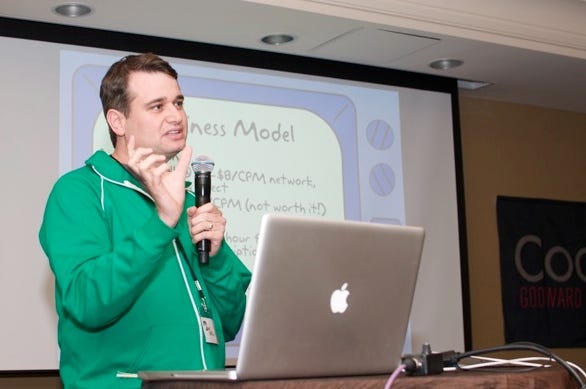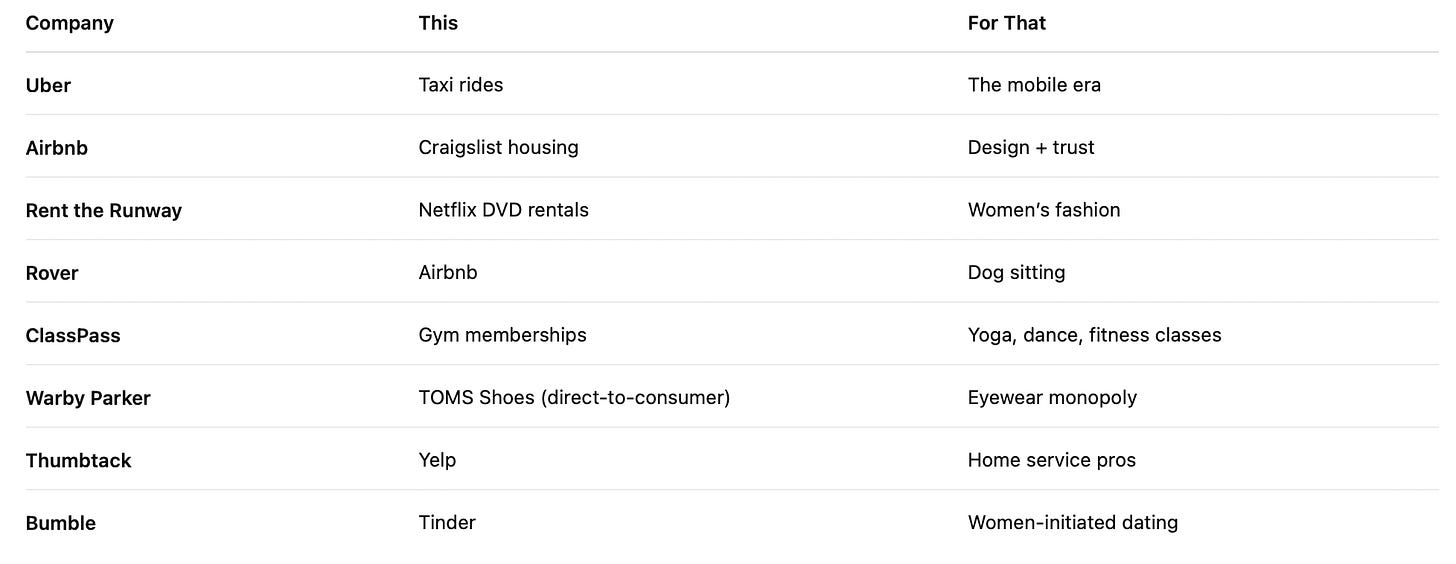Remix to Innovate
Why “This for That” Is Your Startup Superpower
When I gave the keynote at the Milken Institute’s American Dream Festival this past week, the crowd expected me to talk about big ideas.
They probably assumed I’d say something about inspiration. About passion. About chasing dreams.
Instead?
I talked about remixing.
More specifically: remixing creatively.
And they loved it.
Because here’s the truth most people don’t realize:
One of the most powerful paths to innovation is remixing what already works.
It’s a technique I call “This for That”, and it’s not just clever. It’s repeatable, scalable, and incredibly effective at helping people generate real, fundable, buildable ideas fast.
What Is “This for That” Innovation?
“This for That” is the art of borrowing proven business models from one industry and applying them to another.
It’s when you take the mechanics of Uber… and apply them to dog sitting.
It’s when you take the Netflix rental model… and apply it to fashion.
It’s when you take Craigslist… and add design and trust to build Airbnb.
It’s not just clever. It’s powerful.
Because analogies help you think clearer, pitch faster, and get to traction sooner.
A Real Story: How “Airbnb for Dogs” Became a $350M Company
A few years ago, my friend Greg Gottesman entered a startup weekend in Seattle. He didn’t have a brilliant breakthrough idea.
He had a dog.
And like many dog owners, he hated putting her in a kennel every time he traveled.
So, he asked himself:
“What if I could just Airbnb her with another dog lover?”
He pitched the idea: “It’s Airbnb for dogs.”
Everyone got it. Immediately.
A small team built the MVP that weekend.
They launched.
They raised capital.
And today, Rover.com is a publicly traded company that’s raised more than $350 million and has over 2 million pet parents using it.
That’s the power of remixing a model people already trust.
Why Analogies Are a Superpower
1. They build instant comprehension.
When you say “It’s like Uber for…,” your audience immediately gets it. No 30-slide decks. No confusion.
2. They signal credibility.
You’re building on a model that already works. That’s comforting to investors, cofounders, and customers alike.
3. They create momentum.
You can skip the mental gymnastics of starting from scratch. Instead, you’re adapting something proven into a new context.
Famous “This for That” Examples
Here are a few iconic companies that used this exact technique:
Each of these companies succeeded not because they were completely novel, but because they translated something that worked into a new domain.
Framework: How to Use the “This for That” Technique
Step 1: Identify Models You Admire
Make a list of 10 business models you love or understand well.
These might include:
Uber (on-demand)
Airbnb (marketplace of trust)
Substack (creator monetization)
Duolingo (gamified learning)
Calm (habit-forming wellness)
Kickstarter (crowdfunded discovery)
Tinder (swipe-based matching)
Step 2: Identify Customer Groups You Know
Make a second list of 10 target audiences or markets you understand:
College students
Parents of young kids
Remote workers
Dog owners
Freelancers
Teachers
Corporate managers
Travelers
Healthcare workers
Retirees
Step 3: Mash Them Up
Now create combinations like:
Kickstarter for teachers
Uber for healthcare workers
Tinder for finding freelancers
Substack for parents
Don’t worry if they sound bad at first.
That’s the whole point — bad ideas are how good ideas are born. (See Post 1 in this series.)
The more combinations you create, the more likely you are to strike gold.
Exercise: The Idea Crossbreeding Grid
Here’s a simple but powerful worksheet I taught at Milken:
You can easily generate 100+ ideas in 30 minutes.
And most won’t be great.
But that’s the point.
Quantity leads to quality.
How to Use “This for That” Inside Teams
Here’s why this framework is a killer tool for companies and teams looking to build their creative capacity:
It de-risks the blank page.
Your team isn’t starting from scratch. They’re building on existing patterns.
It levels the playing field.
Everyone understands analogies. Even the “non-creative” people suddenly have great ideas.
It encourages bold remixing.
You get ideas that push boundaries but are still explainable and actionable.
Pro tip: Run this as a team exercise once a quarter. You’ll be shocked how many viable products emerge from a simple brainstorm grid.
But Is It Really Innovation If You’re Copying?
Let’s address the elephant in the room.
“Isn’t this just copying?”
Here’s what Steve Jobs said:
“Good artists copy. Great artists steal.”
When Jobs built the Macintosh, he didn’t invent the graphical user interface (Xerox PARC did). He remixed it.
He combined design, technology, and storytelling into a new product that changed the world.
True innovation is reassembly, not just originality.
Final Takeaway
You don’t need to wait for a spark of genius.
You need a framework that works.
And “This for That” is one of the best.
Start by identifying models you admire.
Then combine them with audiences you understand.
Say them out loud. The pitch should feel obvious, almost silly.
That’s when you know you’re onto something.
Because great ideas often sound like bad analogies… until they’re billion-dollar companies.
Next in the Modern Ideation Series:
→ Post 4: Steal from the Best: Copycats, Constraints, and the Innovation Echo (featuring Gmail, ClassPass, and how the best innovators don’t just solve problems… they skate where the puck is going.)




